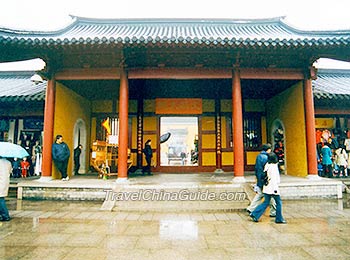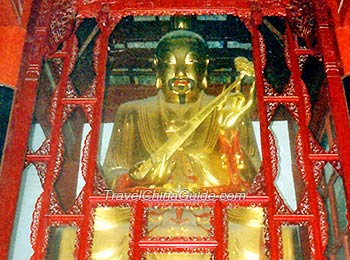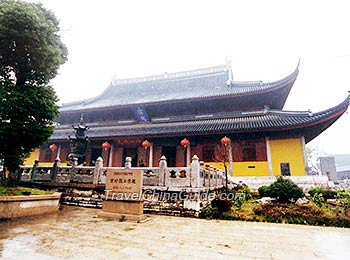Xuanmiao Taoist Temple (Temple of Mystery)
 |
Arriving at the Temple, visitors first see a wooden structured Mountain Gate (Zheng Shan Men). Facing south, it has two side gates: the West Gate and the East Gate. Some Chinese characters are inscribed on the front and back sides of the plaques hung on the gates. The gate was originally built during the Tang Dynasty (618-907) and was rebuilt in 1775. Inside it stand six statues of Taoist Gods including four marshals and two generals. On the right side of the gate stands a tablet which commemorates the restoration of Xuanmiao Taoist Temple.
Covering an area of about 1,300 square yards (1,087 square meters), the Pure Trinity Hall (San Qing Dian) is the main hall here. Built during the Song Dynasty (960-1279), this hall features wood constructions. Standing in front of the hall, tourists will find a plaque hung overhead with three Chinese characters "San Qing Dian" written on it. Entering the hall, visitors can see another large plaque hung on the crossbeam with four Chinese characters "Tai Chu Chan Jiao" written by Qianlong (1711-1799), a famous emperor of the Qing Dynasty (1644-1911).
In the hall stand statues of the trinity San Qing (three Pure Gods) for people to worship. In the middle is Yu Qing (Jade Pure). On the left and right sides of Yu Qing stand Shang Qing (Upper Pure) and Tai Qing (Great Pure). The three statues are gold-gilded clay sculptures, each with a height of about 23 feet (7 meters). They look solemn and imposing as if they were alive. On the left of the three statues stands a special tablet. An epigraph of Li Longji and the figure of Lao-tzu are both engraved on the tablet. Li (685-762) was an emperor of the Tang Dynasty. Lao-tzu was the founder of Taoism as well as a great thinker during the Spring and Autumn Period (770 BC-476 BC). The figure was drawn by Wu Daozi (680-759), a very famous painter from the Tang Dynasty.
 |
Looking up at the ceiling of the Pure Trinity Hall, tourists will be delighted by the colorful patterns of clouds, deer, cranes and the eight famous immortals. Also in the hall stand about forty huge vermilion pillars. The bottoms of the pillars are designed in the shape of basins. About one hundred and eighty Taoist Deities are carved on the thirty octagonal pillars standing outside the Pure Trinity Hall. The railings in front of the hall are constructed from engraved lotus columns and relief stones. They blend harmoniously with the hall.
 |
Other halls in Xuanmiao Taoist Temple including the Hall of the God of Wealth (Caishen Hall) and the Hall of Wenchang Star in charge of one's wisdom and official career are also worth visiting. In the Hall of the God of Wealth stand three Gods: Bi Gan, Zhao Gongming and Guan Yu. In the Hall of Wenchang Star stands a statue of Zitong Dijun who determines people's official careers. On both sides of him are statues of Confucius and Zhu Xi. Confucius (551 BC-479 BC) was a great thinker and educator during the Spring and Autumn Period as well as the founder of Confucianism. Zhu Xi (1130-1200) was a famous philosopher and teacher during the Song Dynasty.
After visiting the various halls, visitors can enjoy Taoist music and the flying cymbals performance to relax. Taoist music in Suzhou absorbs the best of the local folk music, for example, Kunqu Opera. It sounds deep and slow, can be gentle or strident, and has the lingering charm of the palace music. The flying cymbals performance is a delightful entertainment activity. Tourists will be surprised at the performers' stunts.
Finally, tourists can visit the Food Street opposite the Mountain Gate for a meal or go shopping on Guanqian Street to end their trip.
Transportation
Suzhou Bus Search
Admission Fee & Opening Hours
| Admission Fee | CNY 10 (for visiting the temple on ordinary days) Half ticket for minors aged 6-18 and seniors between 60-70. Free for children below 1.4m (4.6ft) or under 6 and seniors over 70. May 22 is the free Open Day. CNY 20 (for visiting the temple during the period from Chinese New Year's Eve to January 5th on Chinese lunar calendar) CNY 35 (for the Xuanmiao Taoist Temple, plus the Taoist music and flying cymbals performance) |
| Opening Hours | Spring, summer and autumn: 07:30-17:00, last entry at 16:45 Winter: 07:30-16:30 |